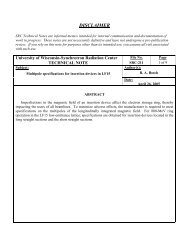SRC Users' Meeting - Synchrotron Radiation Center - University of ...
SRC Users' Meeting - Synchrotron Radiation Center - University of ...
SRC Users' Meeting - Synchrotron Radiation Center - University of ...
Create successful ePaper yourself
Turn your PDF publications into a flip-book with our unique Google optimized e-Paper software.
Fig. 2: Comparison <strong>of</strong> the experimental initial state bulk band structure <strong>of</strong> Bi along<br />
the T direction with various model calculations.<br />
Furthermore, scattering events can play a significant role in the interpretation <strong>of</strong><br />
photoemission spectra. They lead to various phenomena that can be observed in the<br />
photoemission spectra. It has been shown for bismuth that scattering events induce loss features<br />
in the 5d-core level spectra [2], which can be associated with interband transitions inside the<br />
crystal. In the normal emission spectra we present here secondary cone emission features, which<br />
result from transitions involving reciprocal lattice vectors not parallel to the normal emission<br />
direction, can be observed. For these features to be observed in the normal emission spectra the<br />
photoelectrons need to be scattered back into the normal emission direction. We show that for a<br />
complete data analysis secondary cone emission phenomena have to be included. The presence<br />
<strong>of</strong> secondary cone emission features in the spectra clearly shows the significance <strong>of</strong> scattering<br />
phenomena in photoemission spectra <strong>of</strong> bismuth.<br />
Figure 2 shows the extracted initial state bands (black lines) in comparison with a third<br />
neighbor tight-binding calculation [3], as well as two first principle calculations [4, 5] (dotted<br />
lines). The agreement in the dispersion is mostly qualitatively. The tight binding calculation has<br />
difficulties reproducing the dispersion <strong>of</strong> the middle band, whereas the calculation by Gonze [4]<br />
shows the best agreement with the experimental initial state bands.<br />
[1] G. Jezequel, J. Thomas, and I. Pollini, Phys. Rev. B 56, 6620 (1997)<br />
[2] C. R. Ast and H. Höchst, Phys. Rev. Lett. in press (2003).<br />
[3] Y. Liu and R. E. Allen, Phys. Rev. B 52, 1566 (1995)<br />
[4] X. Gonze, J.-P. Michenaud, and J.-P. Vigneron, Phys. Rev. B 41, 11827 (1990)<br />
[5] A. B. Shick, J. B. Ketterson, D. L. Novikov, and A. J. Freeman, Phys. Rev. B 60, 15484<br />
(1999)
















